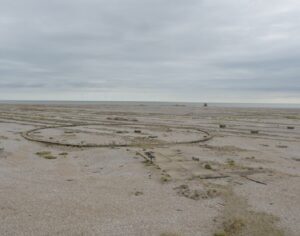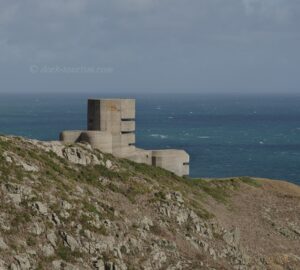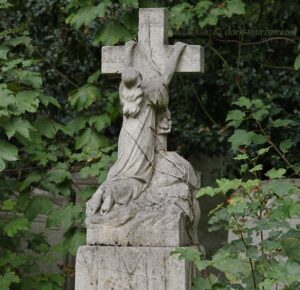A few days ago I returned from my long summer travels, which included a substantial amount of DT fieldwork. The material collected will keep me busy for months as I prepare all those new and updated chapters for my main website. Weeks of photo processing will be the first hurdle.
For this Blog I decided, again, to give just a superficial overview of the trip first, with photos mostly taken by smartphone (just like I did after Bosnia, Portugal, Australia or Taiwan). More details and proper photos will come later in the various website chapters and probably also a series of further more specific Blog posts. For this post I’m concentrating only on the England road-trip part of the trip, which was a month long alone. The add-ons of London, the Channel Islands as well as Saint-Malo and Paris at the end will be covered in later posts. It would have been too much all in one go.
So off to England. On this trip I didn’t do only DT, but also some other things, in particular visiting friends and family (my wife’s family, that is, so my in-laws and other relatives). But here I will concentrate exclusively on the DT elements – and there were plenty!
The trip started by flying into Heathrow, London, where we picked up a hire car for four weeks. First stop was Folkestone, where I visited the Battle of Britain Memorial. The landscaping around the central monument is supposed to look like the shape of a propeller of a Spitfire fighter plane:
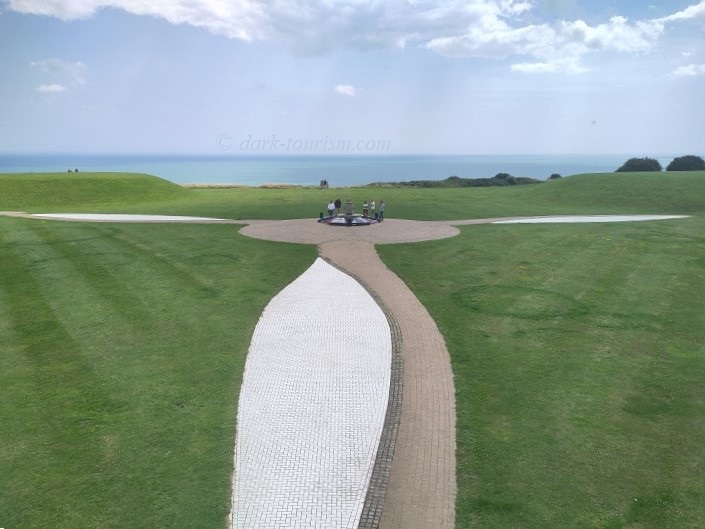
Apart from the symbolic and commemorative memorial monument bits there was also a museum with a heavily commodified multimedia exhibition. More on that in the future chapter for this place …
En route or afterwards I had hoped to also see the St Leonard Church Ossuary in nearby Hythe, but when I got there I found the church car park closed and there was absolutely nowhere to park anywhere near, so I had to give up in the end. Shame, but what can you do …
The next day the trip continued towards Portsmouth, but en route I built in a brief stop at Dungeness. This deceptively Scottish-sounding place on the Kent coast features a unique juxtaposition of a sleepy seaside community, including an old lighthouse, with a massive hulk of a nuclear power station.
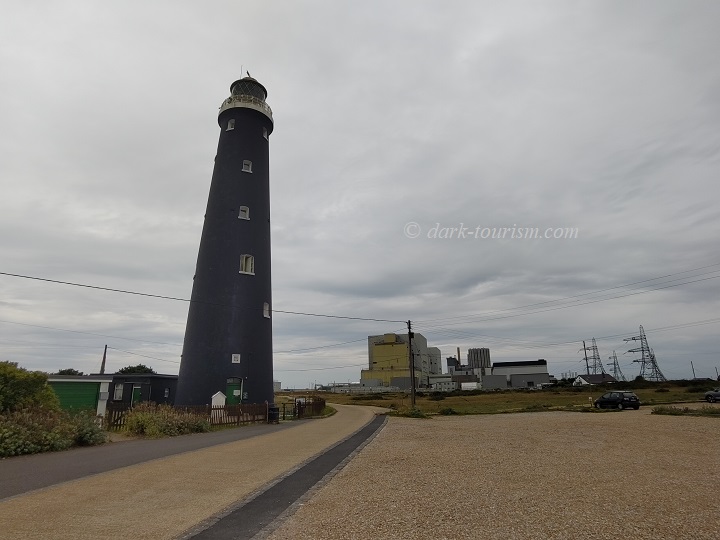
Dungeness NPP is actually two plants with two reactors each: Dungeness A, dating back to the 1960s, and Dungeness B, which became operational in the 1980s. The older plant was shut down in 2006 and has been undergoing decommissioning since then, site B was finally closed in 2021 and will now also enter decommissioning. Plans for a site C were abandoned due to the unstable environment with shingle coastline erosion and risks of flooding. Indeed the site has never been fully safe. Signs around the plant mentioned a visitor centre so I drove up with the intention of taking a look inside. But the friendly staff at the desk in the sleepy reception building informed me that the visitor centre hasn’t been open in years – they had just failed to update the panels. So I drove off and headed to Portsmouth.
Portsmouth was on my itinerary for the “D-Day Story” Centre/Museum. The two exhibitions there I found interesting but again just a little too celebratory, glorifying even; but you get that a lot in Britain. The star exhibit of the centre is outside on (almost) open-air display (under a protective roof) and it is truly unique: the last surviving landing vessel that took tanks on to the D-Day Beaches of Normandy in June 1944. Today the preserved vessel also has two restored tanks on board:
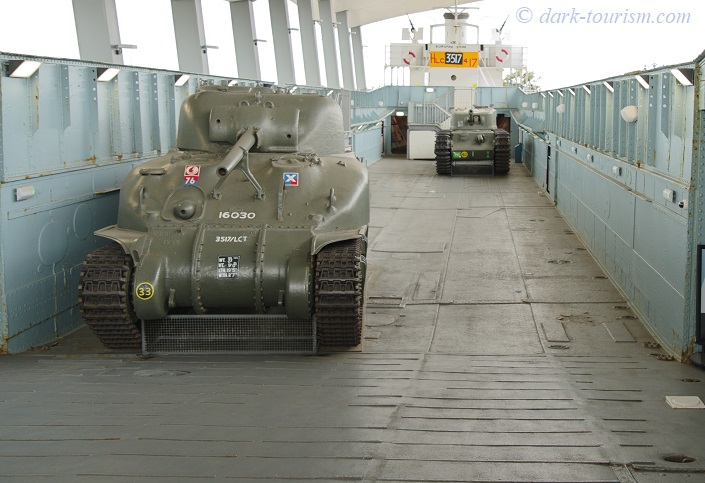
The following day the first destination planned was Greenham Common, a site in Berkshire infamous for the Cold-War-era storage of nuclear weapons – and the high-profile protests against these weapons by an all-female anti-nukes organization. The old US airfield has meanwhile been “re-naturalized” and cows graze where once USAF planes landed and took off. The old nuke storage bunkers are still out of bounds and can only be visited from the outside on guided walks. However, these take place only very rarely, and I was unable to book a place on one of those. The only element that can regularly be visited by the general public is the former control tower building:
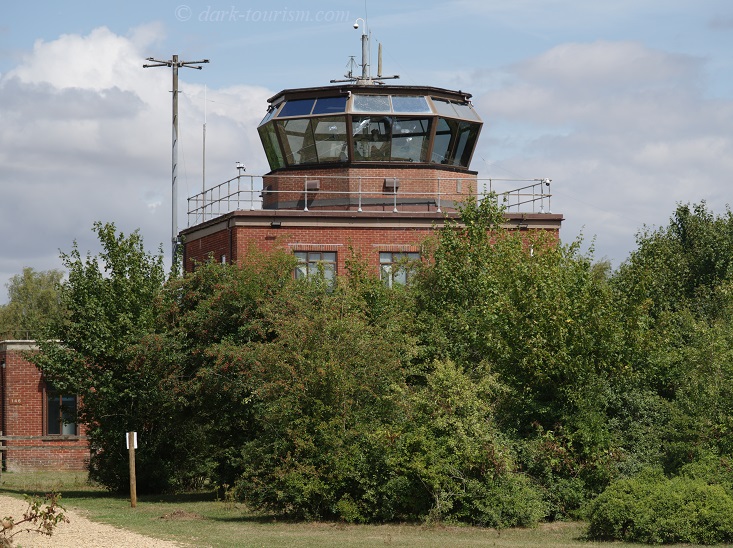
Inside is a volunteer-run exhibition about the site’s history and the protest movement. And on the ground floor is now a cafe – and most visitors come here not so much for the dark history, but to enjoy the new landscaped areas, walk their dogs, and have a cup of tea and a snack at the cafe.
My next port of call would have been Tyneham village, in south Dorset. This has been a ghost town since it was requisitioned by the military at the end of 1943 and all 225 inhabitants were evacuated, never to return. The village and a sizeable area around it are still in the hands of the MoD and serve as a training ground and firing range for tanks and armoured vehicles. At weekends and during periods when the range is not in use, there is limited public access, though. The day of my planned visit should have been a downtime for the range but when I got there I already saw the red warning flags flying on the edge and indeed the gate was closed. I later found out online that it would only be opened for a couple of hours in the evening, but I had accommodation and a dinner table reserved further on my route, and hence wasn’t able to wait for the evening opening. So Tyneham became the second item on my itinerary that I missed out on (and it wasn’t to be the last … see below).
The following day I had only a small DT site on my to-do list, which however required a disproportional detour down narrow West Country lanes, namely to see the Exercise Tiger Memorial in Torcross, Devon:
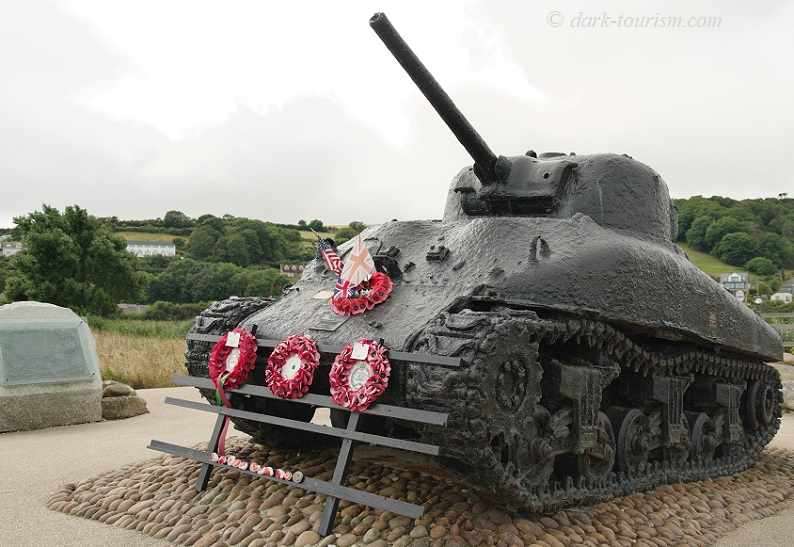
The main element other than the commemorative plaques is an original Sherman tank that was salvaged from the sea where it was lost in 1944 during a military exercise in the run-up to D-Day that went disastrously wrong. Details of this will be covered in the future chapter for this site on DT. For this brief overview let’s move on to the next destination:
That was Bodmin Jail in Cornwall. Most of the former prison has been converted into a hotel, and I actually had a room booked there to coincide with my birthday. The rooms each consist of three former cells with the walls between them removed. Two ex-cells now form the bedroom, and one serves as a large bathroom. It was indeed a very plush, almost luxurious place to stay, and also featured a classy restaurant. Of more relevance for DT is one part of the former prison that has been converted into a proper visitor attraction. This is in the OTT “immersive” style with lots of sound-and-light installations and even fake sea spray sprinkled on to visitors at one point. Such a style seems to be in demand, going by the numbers of other visitors, but for me it was a bit too cheesy and overcommodified. And it was only some parts that really covered truly dark aspects. Here I’ll give you just a photo of the outside of the building (actually the hotel part):
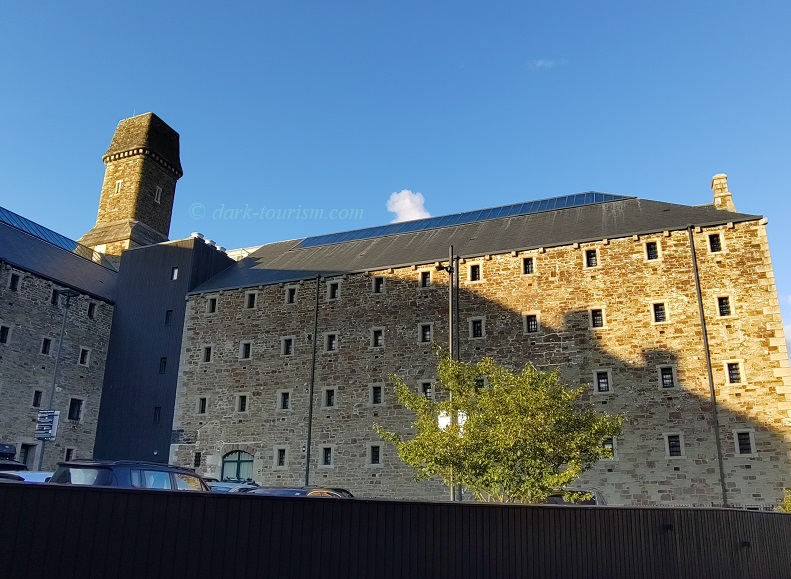
The next day my drive took me along Cornwall’s extremely picturesque north coast but my DT destination for the day was Lynmouth in North Devon. I had been to Lynmouth before, decades ago, long before I even started my DT website. But I remembered the Lynmouth Flood Memorial Hall, which commemorates the disastrous flood of August 1952, when after prolonged heavy downpours the River Lyn swelled to a catastrophic torrent that destroyed dozens of houses and bridges, killed 34 people and made a further 400 or so homeless. So the place warranted a return visit for proper inclusion in my DT website. Here’s just a picture of the memorial hall, its exhibition housed on the upper floor of what was once a lifeboat station (how fitting!):
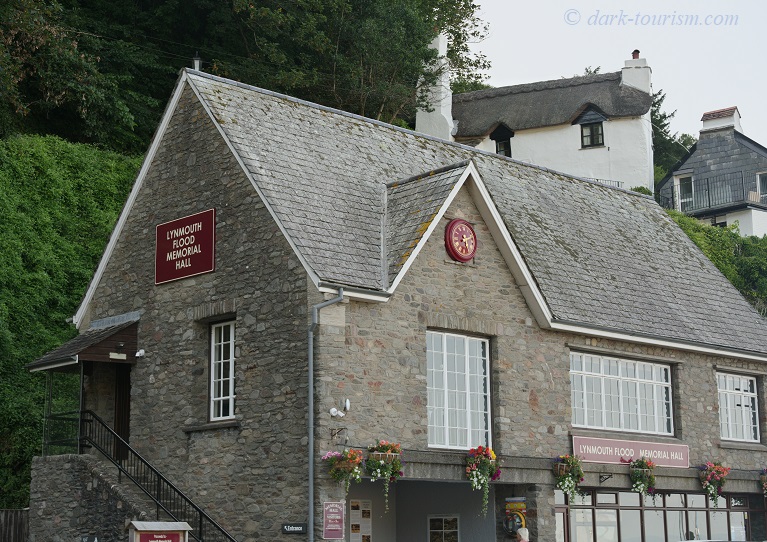
The following day, en route north, I made a short stop at the Old Severn Bridge:
.
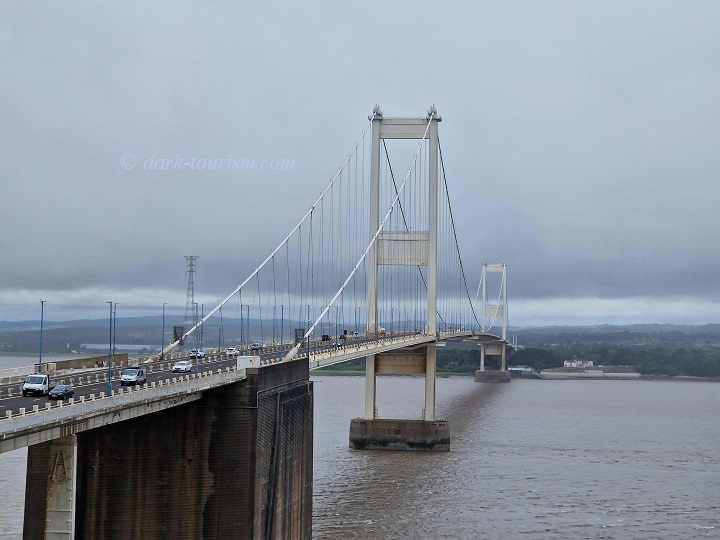
This had an element of dark pilgrimage to it: it was here that the car of Richard James Edwards, aka Richey Manic, then lyricist and guitarist with the Welsh rock band The Manic Street Preachers, was found abandoned in 1995 – and Richey remained disappeared. He had mental health issues and is presumed to have committed suicide by jumping off this bridge … though devout fans (my wife is one) still live in hope that maybe, just maybe, he’s living somewhere in hiding and might one day reappear. I’m rather with the more realistic suicide theory. He was officially declared dead in 2008.
From there the drive took us to one of the most controversial dark-tourism sites anywhere: Littledean Jail in Gloucestershire, not far from the Welsh border. It’s actually one of the very, very few sites that openly advertise themselves as dark-tourism attractions – so for evidence of this I had to photograph the relevant sign by the car park:
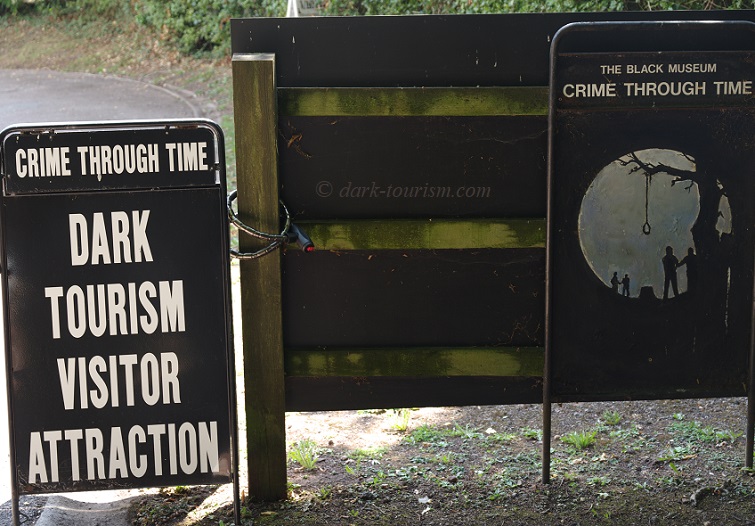
In addition there are loads of warning signs saying that the “Crime Through Time” exhibition inside is not for the faint-hearted and that those easily offended should rather stay away. Indeed amongst the amassed hotchpotch of the exhibition are plenty of displays of a very controversial nature, too offensive for many. But among the provocations and “bad taste” exhibits were also many that were quite enlightening and eye-opening (e.g. about the 1930s British Nazi movement BUF!). I had long resisted giving this place coverage on my website, but will now include a chapter about it. It will reveal many of the controversial aspects … But here let’s move on to something far less problematic.
Driving further in the direction of Birmingham I made a short stop in Worcester to visit the George Marshall Medical Museum. This turned out to be much less icky than some of the other medical museums I have seen elsewhere. No body parts or deformed babies in formaldehyde or wax models of ugly diseases here, just medical history and the tools for it. One section was a bit darker insofar as it covered “war surgery”:
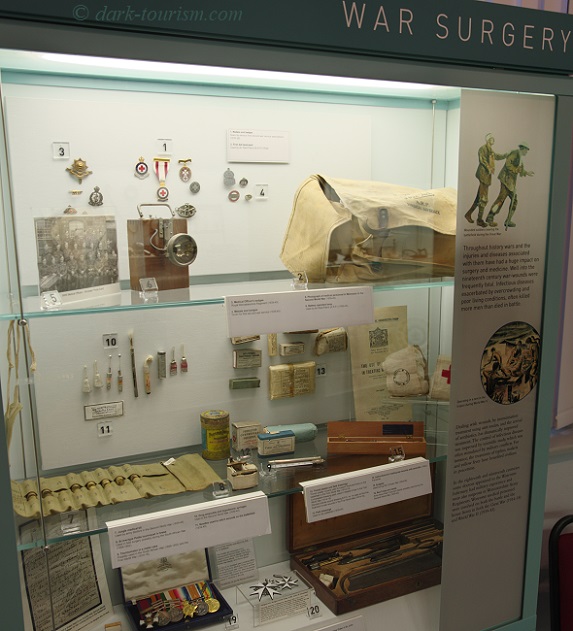
While staying on the edge of Birmingham for a couple of days, I also ventured into the city centre and headed for the “Black Sabbath Bridge”. This is a memorial dedicated to one of the best-known rock groups to ever have emerged from Birmingham, an outfit whose guitarist Tony Iommi is widely credited with having single-handedly invented the heavy-metal style of electric guitar playing. And that was partly brought about by an accident when as a young man he jobbed at a workshop where a machine he wasn’t even supposed to operate chopped off the tops of his right hand’s middle and ring fingers (and since he’s left-handed, the right hand is the fretboard hand). Ever since he has played using specially made thimbles on those fingers. But for that to work he had to resort to very light strings, which in turn formed a characteristic aspect of his guitar-playing style.
At the time I visited, however, it was all about Black Sabbath’s original lead singer, Ozzy Osbourne, who had just given his final farewell concert less than three weeks before he passed away on 22 July 2025. The outpouring of grief and mourning in Birmingham on the day of his funeral was gigantic. This was just a few days before my visit and while lots of the Princess-Diana-like masses of flowers and wreaths placed at the Black Sabbath Bridge had meanwhile been cleared away, there were still quite a few on the plinth of the band memorial:
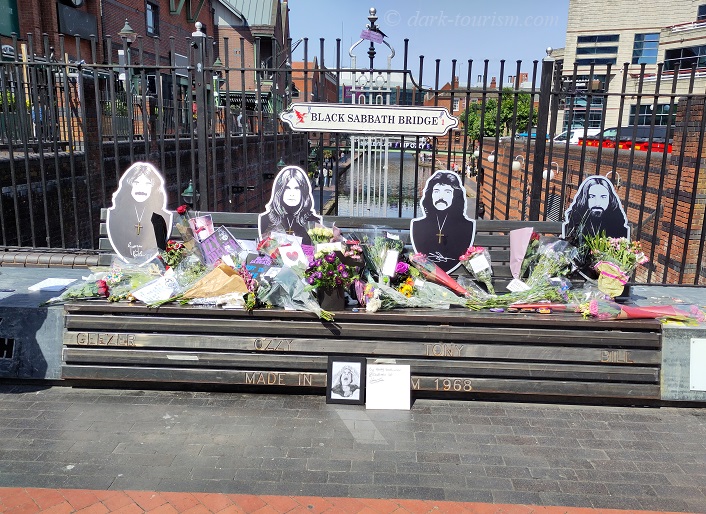
A dark attraction that had long been in the planning for me is a site called “The Coffin Works”. This place didn’t actually manufacture coffins as such, but was a world-leading metal workshop for outfitting coffins. After its closure the factory was converted into a unique museum of sorts, giving insights into a normally not so visible branch of the “death industry”, so combining the dark with small-scale industrial archaeology. Here’s a photo of the original company gate, still in place:
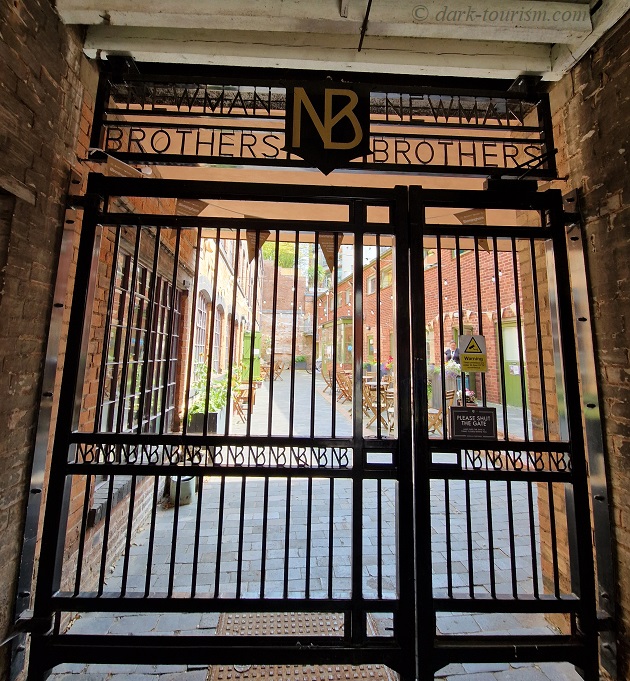
After Birmingham our route took us further north, namely to Barrow-in-Furness, where we visited the Dock Museum:
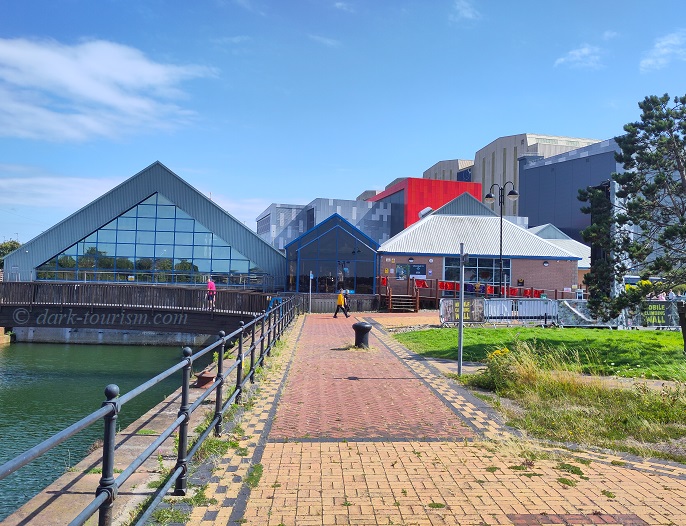
Inside, its exhibitions include parts about the “Barrow Blitz”, i.e. the bombing of the place by the Nazi German Luftwaffe during WWII. The town was a target especially for its industry, including major shipyards. This industry continued after the war, notably with the building of submarines, so there’s also some Cold-War history here. An unexpected element was an extra exhibition called the “Dave Museum”. This is dedicated to Dave Myers, one of the “Hairy Bikers” of British TV fame (basically two bearded motorcyclists doing a cooking programme series). Myers was from Barrow and had passed way only in 2024, so this exhibition was put together as a special tribute.
Driving north from Barrow into the Lake District I made a stop in Coniston to revisit the Ruskin Museum. A good part of this is an exhibition about the multiple land-speed record holder Donald Campbell, who perished on Coniston Water in 1967 when his Bluebird K7 jet-powered speedboat flipped over and crashed. I had been to the Ruskin Museum before, but now a return visit was due because only recently the restoration of the salvaged Bluebird was completed and the vessel has been put on display:
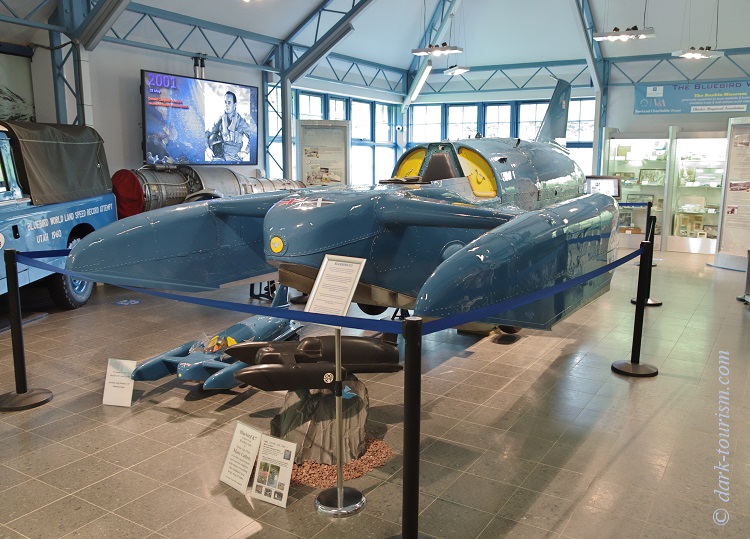
My next destination was Carlisle in the north of Cumbria. It was more for logistical convenience as a stopover en route to Northumberland, but there are some dark elements in Carlisle too, which I had only recently learned about. This is a photo of the historic Shaddon Mill with its “Dixon’s Chimney”:
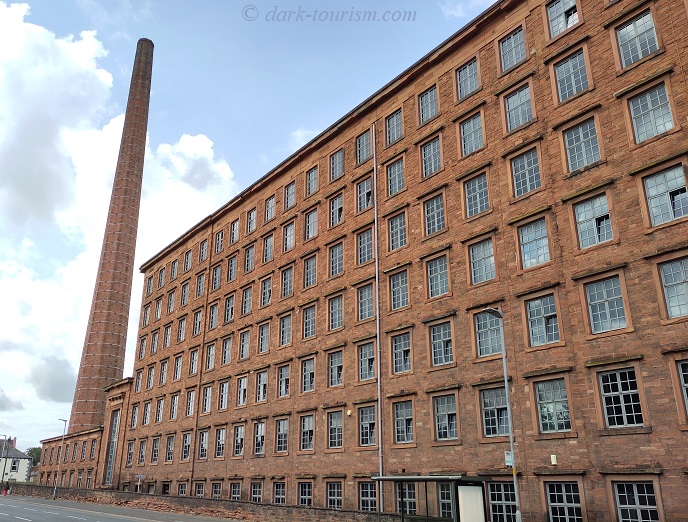
The dark element here is that in 2019 a man climbed the steps up the chimney, slipped and became trapped, hanging upside down by one foot. A rescue operation was mounted, but the man could not be saved before he died of hypothermia and brain swelling (from hanging upside down for many hours). There is a plaque on the chimney, but that only marks its refurbishment (the whole mill was converted for other uses), and says nothing about the accident. Why the man climbed the chimney is unclear, but there is a theory that he may have intended to jump off the top to commit suicide. So he could have died anyway, just in a less unpleasant way …
A more “conventional” dark site, perhaps, though an almost completely uncommodified one, is what remains of the former Featherstone Park POW camp in Northumberland. Here is a photo of some of the remaining brick ruins:
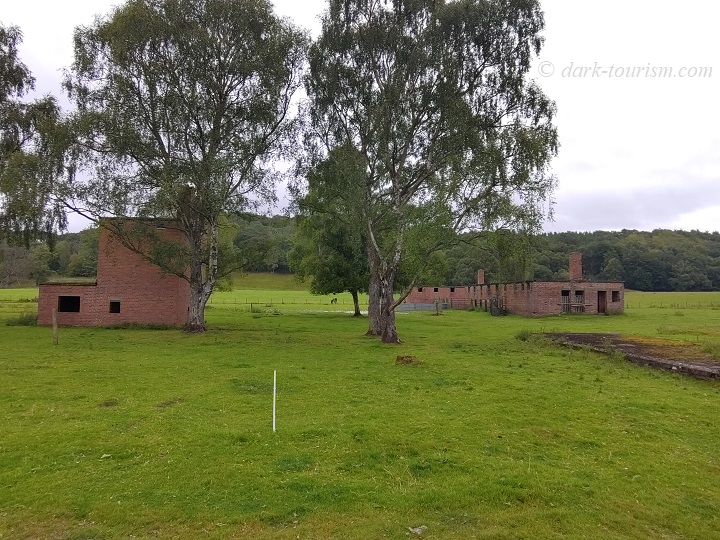
This camp next to Featherstone Castle was for German Nazi officers taken POW by the British. These officers were naturally deemed most indoctrinated by Nazi ideology and hence the most difficult to “re-educate”. Yet, thanks largely to one Herbert Sulzbach, a German Jew who had fled to Britain in 1938, joined the British military and from 1946 served as an interpreter at Featherstone, some important groundwork for Anglo-German reconciliation was laid here …
Not far away I also visited the Solway Aviation Museum, one of many such museums in Britain. It has a number of planes on open-air display and a pretty good, mostly Cold-War-focused indoor exhibition. But the star exhibit is this original Avro Vulcan bomber (originally designed in the late 1940s/early 1950s to deliver British atomic bombs, but later used in many other conventional ways, including in the Falklands War):
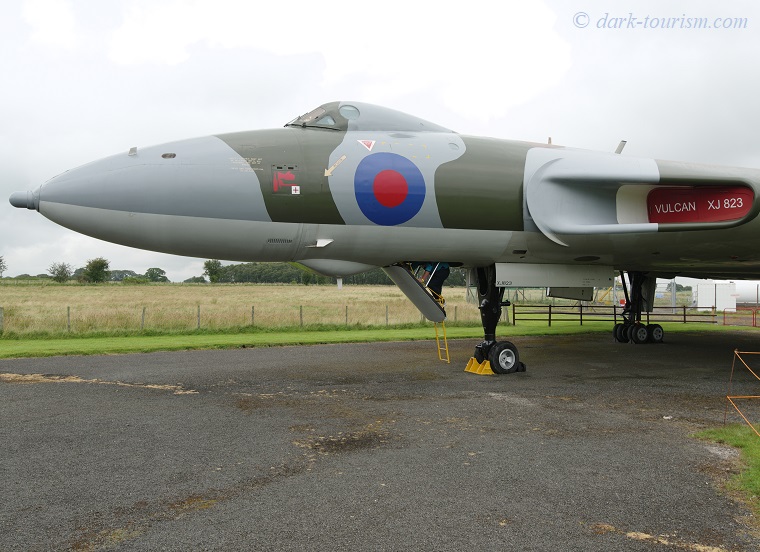
The icing on the cake is that at Solway you can climb into the cockpit of the Vulcan, on guided tours with specified time slots, but at no extra cost (very much unlike at IWM Duxford, where they charge a hefty extra fee for the privilege!). That was quite special!
In Northumberland my wife and I were staying with old friends and on Sunday our hosts suggested a family outing to the Woodhorn Colliery Museum. Being a fan of industrial archaeology as well as dark tourism, I enthusiastically agreed. And guess what, DT finds me even when I’m not actively looking for it, as Woodhorn turned out to also have been the site of a couple of deadly mining disasters and was also a mine in which so-called Bevin Boys had to work (see below). Here’s a photo of the main mine buildings:
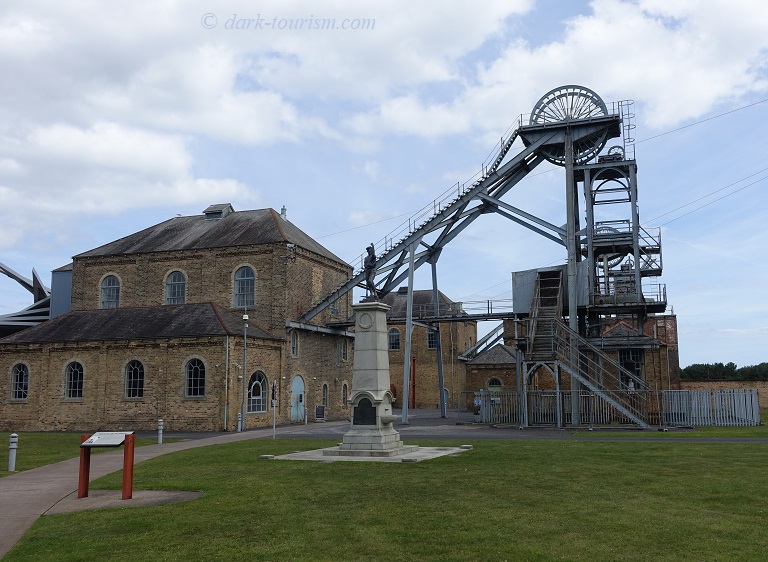
From Northumberland we headed back down south via North Yorkshire and Malton, near which the large Eden Camp is located. This too was a POW camp for captured Germans after WWII, and unlike Featherstone (see above) this has been turned into a major WWII-themed museum/park. Here’s a photo of some of the preserved barracks:
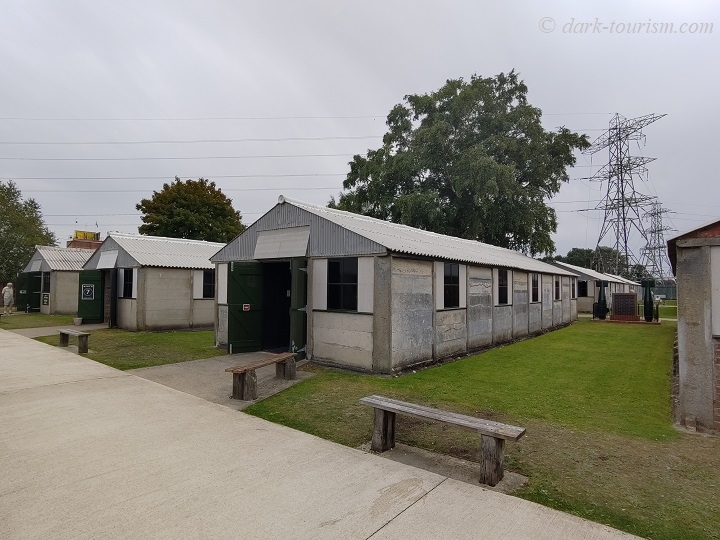
We then had a two-night stopover in Liverpool, where we stayed at the Titanic Hotel housed in a converted harbour warehouse north of the city centre. Like its counterpart in the Titanic Quarter in Belfast, there are plenty of White Star Line posters on the walls inside and a couple of scale models of the Titanic in the reception and bar/restaurant areas to commemorate that vessel’s tragic fate but also to celebrate the era of the Atlantic Liners.
One of the proper dark places in the centre of Liverpool that I visited on this occasion was the St Luke’s bombed-out church, a ruin that was left standing in its semi-derelict state after it was destroyed during Nazi German Luftwaffe raids in May 1941. It now serves as a WWII memorial. Outside stands a pair of bronze statues symbolizing the “Christmas Truce” of 1914 in the early stages of WW1, it’s one German and one British soldier shaking hands over a football on the ground:
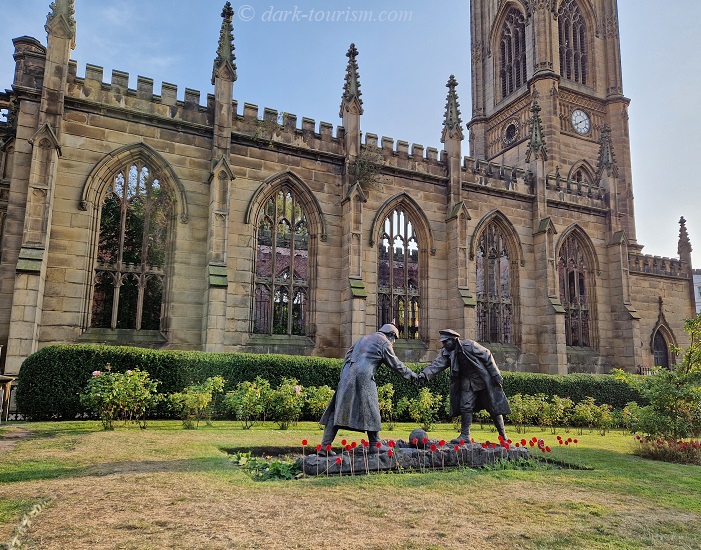
The other place I visited during my stay in Liverpool was the Western Approaches Museum. This occupies the original location of the command centre that co-ordinated the WWII transatlantic convoys and their defence in the Battle of the Atlantic. Here’s a photo of the main operations room:
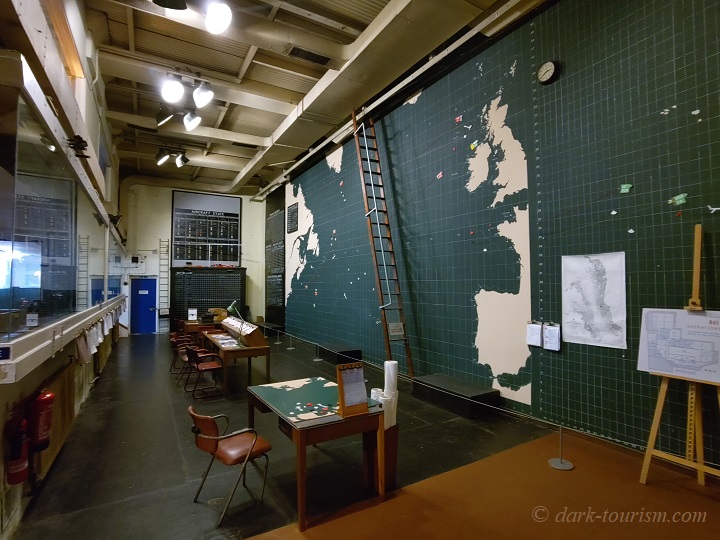
Another dark site in Liverpool, one that I would have visited again, is the International Slavery Museum, but that turned out to be temporarily closed for renovations – it’s scheduled to reopen in 2028.
After Liverpool the plan had been to visit the York Cold War Bunker, now a site managed by English Heritage, and I had a tour booked there – but that was cancelled “for operational reasons” (whatever they may have been) by email a couple of days before the date. So this was yet another site that fell by the wayside on this occasion and that I will have to cover on yet another trip to the UK in the future …
Instead I drove south-west back to Birmingham, and visited Shrewsbury Prison en route. The prison was closed only in 2013 and has been a visitor attraction since 2015. Here’s a photo of the inside of the main cell tract (same image as the featured photo at the top of this post):
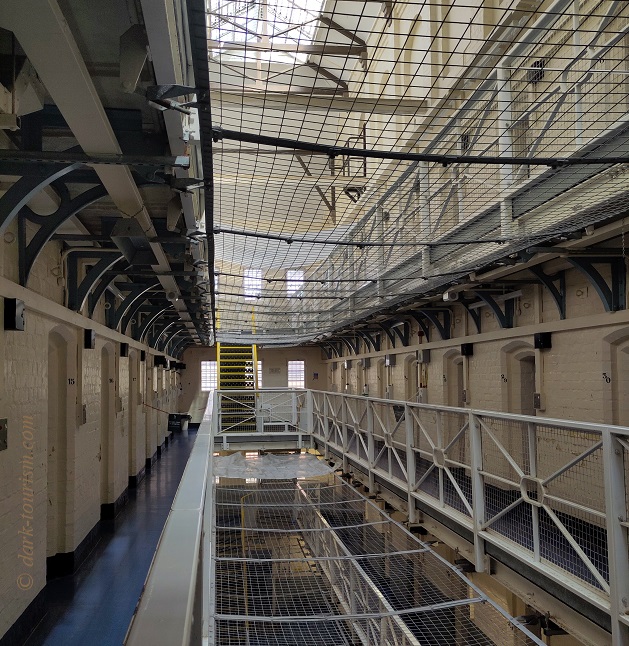
Shrewsbury Prison is yet another rare example of a site openly advertising itself as a ‘dark-tourism attraction’ (see Littledean Jail above).
In fact I had learned about this place, and several others visited on this road trip, through a 2024 book by Leon McAnally called “A Guide to Dark Attractions in the UK”, and the museum’s shop had copies of this on display. If my own book had had a chapter about Shrewsbury Prison they would have stocked my book too, so the shop assistant said, suggesting I include their place in a possible second edition … who knows, maybe one day …
By the way, I had arranged to meet up with Leon in Birmingham during my first stopover there on this trip, and on that occasion we took the opportunity for him to sign my copy of his book and me signing his copy of my book – and we had a good long chat about dark tourism as well! We found much mutual agreement, even though his concept of DT is much wider than mine (I restrict myself to modernity and dark reality only, whereas he also covers medieval and merely mythological and/or ‘paranormal’ sites, hence his book covers over 200 sites that I would not include here or on my main website). But we very much shared the same view on the ethics of DT. That was very nice.
But back to my DT road trip through England. While using Birmingham as a base I made a few excursions, the first of which took me to the Southwell Workhouse in Nottinghamshire:
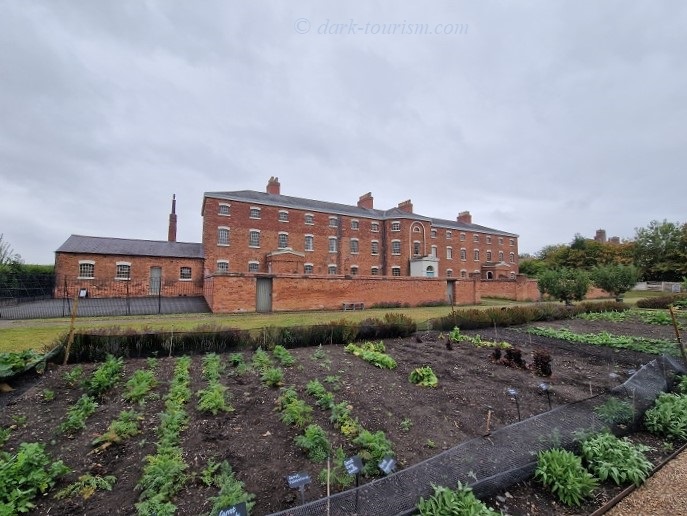
This was a prototypical workhouse for the poor from the 18th century, but it remained in use up until the early 1990s, in its final phase providing temporary accommodation to mothers and children in need. After that it was acquired by the National Trust and turned into the present museum site.
Another site in Nottinghamshire that was very high on my priorities list was the National Holocaust Centre & Museum. Sadly photography inside the main exhibition was prohibited, but I can give you a photo of the symbolic deportation monument outside:
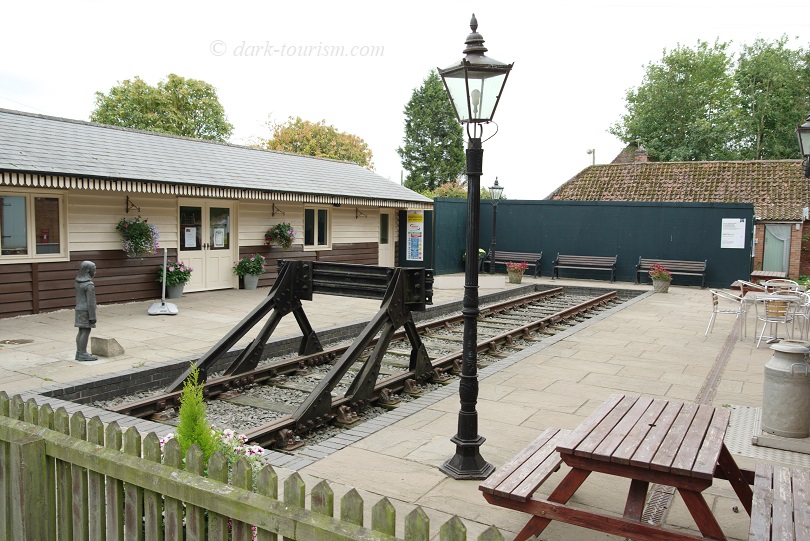
This is the UK’s main Holocaust memorial site, together with the IWM’s now considerably diminished Holocaust Exhibition (compared to its much more impressive predecessor version). The main exhibition covers the usual chronology of the Holocaust, while a newer additional exhibition called “The Journey” is more aimed at schoolchildren and focuses on one individual story of a Jewish kid escaping the Holocaust on one of the “Kindertransporte”.
Yet another excursion took me to the International Bomber Command Centre in Lincoln. This consists of yet another high-tech exhibition (opened in 2018) with multimedia immersive elements, along with a complex of memorial monuments out in the open. Here is a photo of one of them, featuring a scale-model of an Avro Lancaster bomber “in action”:
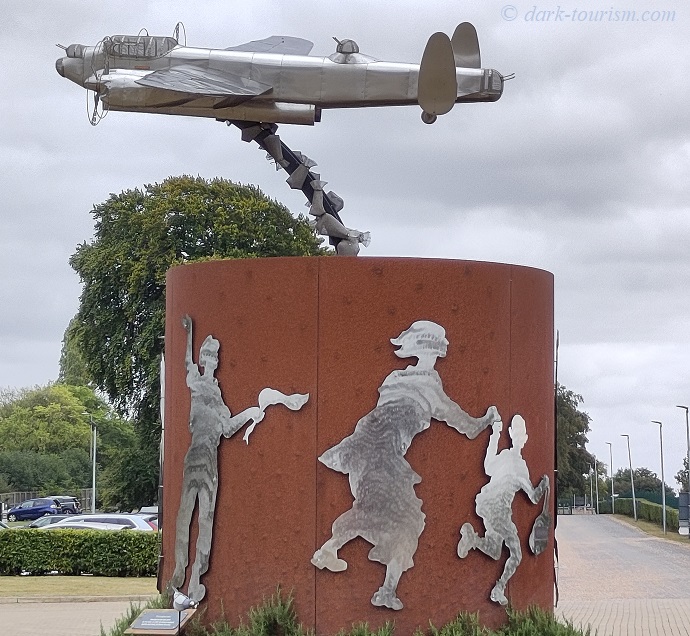
The exhibition focuses largely on the RAF Bomber Command and in particular the high rates of losses of planes and aircrews during the thousands of (mostly night) sorties over Germany. What the exhibition rather lacks is a coverage of the “other” side, i.e. the death and suffering caused to the civilians in cities like Hamburg, Berlin, Cologne or Dresden. The head of Bomber Command, Arthur Harris, aka “Bomber Harris”, who was the main driving force behind those bombing raids on civilian targets, is seen by some as even a war criminal.
On my last day based in Birmingham I went on an excursion to revisit the National Memorial Arboretum in Alrewas, Staffordshire. It was my third visit in fact, and I went primarily in order to see some of the newer individual memorials that have been installed here since my last visit and also to find one I had previously overlooked, namely this memorial stone dedicated to the Bevin Boys:
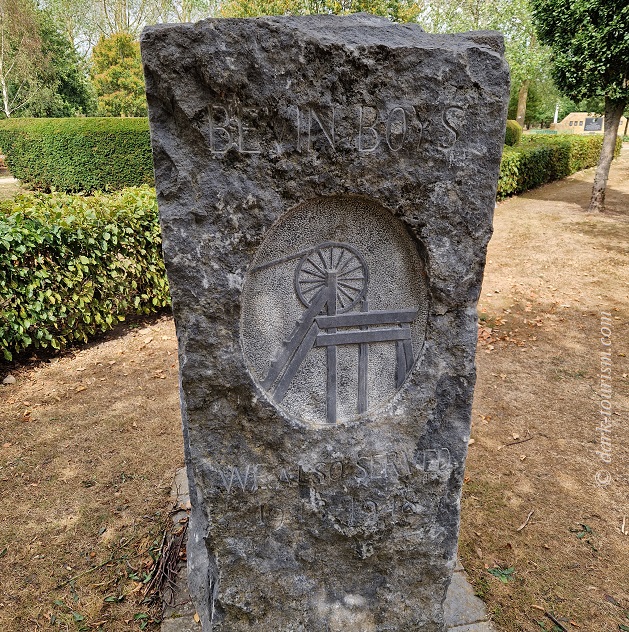
The Bevin Boys (already mentioned above in the context of the Woodhorn Colliery Museum) were young British men forcibly conscripted during WWII to work in the nation’s coal mines, a hard and dangerous (and in some cases lethal) form of labour that they were given little credit for for a long time. At the time they were often erroneously seen as draft dodgers, even though they were chosen by the government (randomly by lots), and they were never given any form of awards or medals. The recognition of this dark chapter of British wartime history (and beyond – some were not released from service until 1948) only began in earnest in the 1990s.
Eventually we headed back south to see a couple more DT sites before dropping off the hire car. Two more places I had intended to visit also fell by the wayside, firstly the Royal Gunpowder Mills, where I had arranged a tour with the site’s manager (who in fact had initially contacted me to suggest inclusion of the place on my website), but then it occurred to her that it would be Bank Holiday Monday, so everything would be closed. By that point I had all my other arrangements in place so I didn’t have the flexibility to rearrange my plans, so this is yet another site to be included on a future return trip to the UK.
The same goes for the Bentwaters Cold War Museum, which changed its opening times between my initial draft travel plans and me then being in the area. So this too has to be left for another occasion.
But what I did manage to see was Orford Ness – and it was a definite highlight of the whole trip! Orford Ness is a shingle spit on the Suffolk coast separated from the mainland and the village of Orford by the River Alde/Ore. For a long time this remote place was a secret military site used for the testing of various types of military hardware, even including nuclear bombs, albeit only for operational tests without any fission material present, during the Cold War, as well as for an over-the-horizon radar installation called Cobra Mist (cf. the Duga installation in the Chernobyl Exclusion Zone!). Much of Orford Ness is now in the hands of the National Trust and tickets for the ferry crossing and admission have to be booked ahead online. Unfortunately the Cobra Mist site is not part of the NT premises but now privately owned and hence inaccessible. The same goes for the installations used by the ‘Atomic Weapons Research Establishment’ locally known as “the pagodas”. These can only be seen on special guided tours that take place only a few times a year and quickly sell out, so I missed out on that (yet another reason for a return visit some other time with more planning in advance!). But I did get to explore the vast area independently and this is as close as I came to the restricted-access Cold-War-era installations:
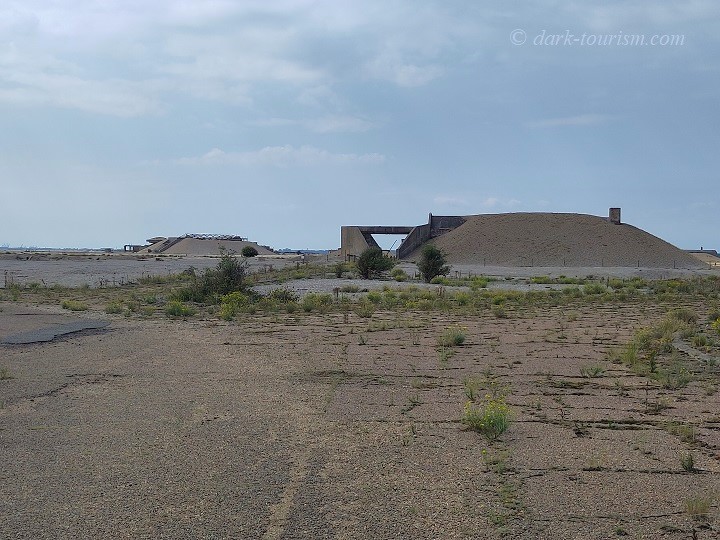
I spent the better part of a whole day on Orford Ness and despite those restricted parts saw a lot that was well worth it – the place may be worthy of a stand-alone Blog post at some point!
After Orford I drove back to London and finally dropped off the hire car at Heathrow. But we didn’t fly home from there and instead first had a few days in the British capital, again to tick off a few more dark attractions I had hitherto not managed to visit on my numerous previous visits to London (this city is a bit like Berlin in that respect – you never quite get to the bottom of it, there’s always yet more to discover).
But that’s for another separate Blog post – as are my visits to the Channel Islands and a couple of places in France at the end of this long summer trip.
At 28 photos and over 30 places covered this is already one of the most substantial posts on this Blog ever. I hope you enjoyed reading it! More from this trip will follow in yet more new posts over the coming weeks and months.

